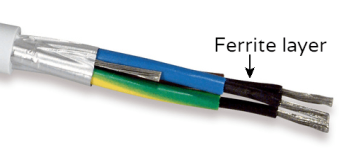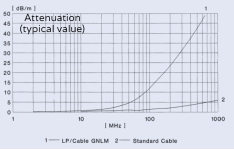Wait! isn't this thread about power cables?
Reading the thread up to the point, hopefully its clear one of the sources of noise on AC lines today is RFI. And so, what RFI does to interact with audio amplifiers is part of what power filters (be they in cable or other form) are supposed to protect against. Some people don't seem to understand how RFI can affect audio. Once again unfortunately some people have to be educated.
Last edited:
Back in the 1990's some printers and desk top computers were shipped with shielded power cords (some also had molded ferrites). The reason was to prevent the power cord from acting as a transmission antenna, radiating interference generated by the unit's power supply.As a test engineer of 40+ years' experience, to me it makes no sense to shield just the last few feet of a long transmission line.
Certainly not by you.Once again unfortunately some people have to be educated.
did he ever correct all the things I pointed out as incorrect in his presentation?I posted that Whitlock presentation (which might be thought of as a white paper on the great benefits of audio coupling transformers) for a particular reason. Just as a reminder, Mr. Whitlock, while very well versed on the subject of grounding and shielding, does come from a certain business perspective. He shows transformers can be an excellent solution, but he says nothing about problems with transformers and what adverse effects they may have on sound. Just sayin' 🙂
jn
jn, not that I'm aware of. Maybe like this: https://www.diyaudio.com/community/...orch-preamplifier-part-ii.146693/post-3048214
It seems to me that he's rather even-handed, considering his position. He also discusses the In-Genius balanced-input chips. From my readings of audio production, full-response audio transformers are used more often as an effect than for isolation - it "adds to the sound" and they don't mind paying the Jensen prices for all the copper windings and the extra-special magnetic materials used. But of course that's not desirable in all circumstances.I posted that Whitlock presentation (which might be thought of as a white paper on the great benefits of audio coupling transformers) for a particular reason. Just as a reminder, Mr. Whitlock, while very well versed on the subject of grounding and shielding, does come from a certain business perspective. He shows transformers can be an excellent solution, but he says nothing about problems with transformers and what adverse effects they may have on sound. Just sayin' 🙂
This Rane note from a while back also "promotes" transformers for similar applications, even though Rane doesn't make transformers, only uses then in some products:
https://www.ranecommercial.com/legacy/note110.html
I don't know if there is a working link to his:did he ever correct all the things I pointed out as incorrect in his presentation?
jn
July 15, 2019
Overview of Audio System Grounding and Interfacing
by
Bill Whitlock
a 210 page Power Point with notes, paper.
He is active on a pro audio forum, lets check.
Here is the 'Overview' document. Talks a little about RF issues.
https://centralindianaaes.files.wordpress.com/2012/09/indy-aes-2012-seminar-w-notes-v1-0.pdf
https://centralindianaaes.files.wordpress.com/2012/09/indy-aes-2012-seminar-w-notes-v1-0.pdf
What things were those?did he ever correct all the things I pointed out as incorrect in his presentation?
jn
Eupen GNLM 3G1,0
- Conductor Cu-Strand VDE 0295, Class 5
- Absorption layer Ferrite (EMC/COM)
- Isolation PVC
- Shielding Aluminium-Polyester Band
- Outer jacket PVC, gray with lettering
- Structure based on VDE 0281 Part 402, Reg.Nr. 11359372
- Dielectric strength: 2 kV
- Capacitance (wire/screen): 400pF/m +/-10%
- Inductance (1 conductor loop): 2,7uH/m +/-10%
- R Conductor: 20,0 Ohm/km
- Cross-section 1,0 qmm (31 Strands x 0,2mm)
- Cross section of braided shield 0,5 qmm (16 Srands x 0,2mm)
- Outer diameter 9,1mm
Specs look really good. The pictures are somethign else, not anything like the specs. No ferrite layer. No braided shield. And I don't understand "Inductance (1 conductor loop): 2,7uH/m +/-10%". Its not real if it doesn't return. Where do you get the cable specified? (although 16 strands would not make much of a shield. The foil shield is a good start.).
The widely-held belief that audio transformers are "ugly iron" and add plenty of audible distortion and limit frequency response is largely true, as I'm quick to point out on pages 137 to 170 in the free download slide set from a typical seminar at https://centralindianaaes.files.wordpress.com/2012/09/indy-aes-2012-seminar-w-notes-v1-0.pdf. The reason I use Jensen products as examples is that I know of no others that publish verifiable specs for comparison ... perhaps Cinemag comes close. In my 25 years of owning Jensen and taking hundreds of customer calls, most customers thought their listening experience was significantly improved when a Jensen was inserted into the signal chain. This is actually quite predictable. The high-end frequency response of Jensen's are intentionally tailored to have a 2nd-order Bessel filter response. So system bandwidth is reduced, but in a way that introduces no phase or time non-linearity (the Bessel flat group-delay characteristic). The late Deane Jensen wrote about "Spectral Contamination" in 1988 and showed that allowing ultra-sonic spectrum to propagate through a system caused audible, non-harmonically-related frequency components to be generated. Limiting system bandwidth this way has the effect of eliminating downstream generation of "the veil" or "grunge" in music. Systems with DC-to-daylight bandwidth simply invite such problems. Further, the distortions at low-frequencies in transformers are due to the magnetic characteristics of its core material, both hysteresis at low levels and saturation at high levels. Jensen has always maintained a trade secret of reducing hysteresis to near-zero with a proprietary annealing process. To minimize low-frequency saturation, there is no substitute for more core material, which makes them larger and more costly than cheap competitors. We also specified them at 20 Hz, while competitors use test frequencies of 30 Hz or 50 Hz to make the numbers look better. They are designed as a "cost is no object" product and I was proud to inherit the company from Deane. Trying to understand exactly how they worked their noise-killing magic led me to fully understand balanced interfaces, which led to my invention of the InGenius(R) circuit. More important, Jensen was a springboard for me to investigate other issues surrounding system noise. An example is the realization that 99% of the ground-voltage differences that challenge noise rejection in pro audio systems is generated by the wires in conduit that carry AC power in the walls of buildings. You can explore this subject in my AES paper "Ground Loops: The Rest of the Story." So yes, I admit to having a slight bias about transformers and those who label them all as awful. I still work, as a volunteer mostly, to dispel myths in the audio industry by being active is standards work for AES, IEC, and UL - as well as lecturing anywhere someone will pay my travel expenses!I posted that Whitlock presentation (which might be thought of as a white paper on the great benefits of audio coupling transformers) for a particular reason. Just as a reminder, Mr. Whitlock, while very well versed on the subject of grounding and shielding, does come from a certain business perspective. He shows transformers can be an excellent solution, but he says nothing about problems with transformers and what adverse effects they may have on sound. Just sayin' 🙂
Sorry for the rant, but anyone who's ever attended one of my lectures knows that I have a very low opinion of marketing in general, with all its half-truths, deception by omission, and outright lies! I never want to be thought of as a marketing guy!
OK, trying to be relevant to the thread title, I should mention another of my patents (with co-inventor Jamie Fox) on power-cable construction to minimize voltage induced over the length of the ground conductor. See https://patents.google.com/patent/US20120103646A1/en
While the contribution to system-level ground voltage differences is small relative to what goes on in building conduit, it can be very important for systems using unbalanced signal interconnections (where only micro-volts of noise can ruin noise floor). Jamie and I sold the rights to this patent to Lapp, a German maker of cables. It will be very beneficial in industrial electronics systems to reduce ground noise caused by variable-speed drives for large electric motors. I'm hoping they might apply it to a "consumer" product like power cords.
While the contribution to system-level ground voltage differences is small relative to what goes on in building conduit, it can be very important for systems using unbalanced signal interconnections (where only micro-volts of noise can ruin noise floor). Jamie and I sold the rights to this patent to Lapp, a German maker of cables. It will be very beneficial in industrial electronics systems to reduce ground noise caused by variable-speed drives for large electric motors. I'm hoping they might apply it to a "consumer" product like power cords.
If you really want to know, you can use the search function at the top of the page. Just search for posts by the particular author, using the search term, Whitlock.What things were those?
Regarding "ugly iron," I would agree the description applies to most audio transformers. That said, I have listened to some cost-is-no-object prototype line-level transformers which to me actually sound good enough to use. IIUC the manufacturer had to make some breakthroughs to develop them. Regarding annealing, IME the prototypes seem to self-anneal with use. Some people might call it in "burn-in," however its a controversial term here in the forum. Anyway, I find that running them hard for 24-hours or so with real music gets rid of most of the initial "crunchiness." Unfortunately for now, I am not allowed to say more on the subject.
Okay, back to power cables...
Okay, back to power cables...
Demian, have you ever noticed any hysteresis noise/distortion produced by ferrites? Bruno Putzeys talks about the effect, and I have seen some circumstantial evidence of it.No ferrite layer.
https://purifi-audio.com/blog/tech-notes-1/this-thing-we-have-about-hysteresis-distortion-3
- Home
- Design & Build
- Construction Tips
- DIY power cable design considerations

